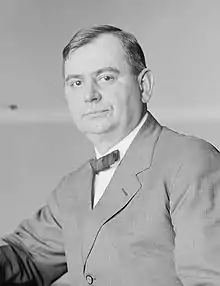
Howard Gore | |
|---|---|
 | |
| 17th Governor of West Virginia | |
| In office March 4, 1925 – March 4, 1929 | |
| Preceded by | Ephraim F. Morgan |
| Succeeded by | William G. Conley |
| 8th United States Secretary of Agriculture | |
| In office November 22, 1924 – March 4, 1925 | |
| President | Calvin Coolidge |
| Preceded by | Harry Wallace |
| Succeeded by | William Jardine |
| Personal details | |
| Born | October 12, 1877 Harrison County, West Virginia, U.S. |
| Died | June 20, 1947 (aged 69) Clarksburg, West Virginia, U.S. |
| Political party | Republican |
| Spouse |
Roxie Gore
(m. 1906; died 1928) |
| Education | West Virginia University, Morgantown (BA) |
Howard Mason Gore (October 12, 1877 – June 20, 1947) was an American politician. He served as the 8th secretary of agriculture from 1924 to 1925, during the administration of President Calvin Coolidge, and he served as 17th governor of West Virginia from 1925 to 1929.
Biography
Gore was born in Harrison County, West Virginia, to farmer Solomon Deminion Gore and his wife Marietta Payne (née Rogers). Gore attended West Virginia University in 1900. He married the former Roxalene (Roxie) Corder Bailey on September 30, 1906. She died on March 7, 1928,[1] and he remained a widower in office.[2]
Gore served as president of the West Virginia Livestock Association from 1912 until 1916. He was appointed to the West Virginia State Board of Education from 1920 until 1925. On November 22, 1924, Gore served briefly as the secretary of agriculture following the death of his predecessor, Henry Cantwell Wallace (1866–1924).
On November 4, 1924, Gore was elected governor of West Virginia in the 1924 election. He assumed the governorship at the end of the partial first term of President Calvin Coolidge on March 4, 1925. Gore then served as the West Virginia Commissioner of Agriculture from 1931 until 1933.
He died in Clarksburg, West Virginia, on June 20, 1947. He is interred there in the Elkview Masonic Cemetery.
References
- ↑ "Roxalene Corder Gore". geni_family_tree. September 11, 1885. Retrieved January 26, 2022.
- ↑ "West Virginia's First Ladies", West Virginia Division of Culture and History, June 2007.
External links
- Biography of Howard M. Gore
- Inaugural Address of Howard M. Gore
- West Virginia & Regional History Center at West Virginia University, Howard M. Gore papers


